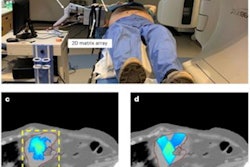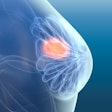
Flash radiation treatment with protons shows promise as a "practical modality to reduce pain," say researchers presenting first-in-human study findings at the American Society for Radiation Oncology (ASTRO) annual meeting in San Antonio.
In a small study of patients with metastatic cancer, the treatment -- which delivers high therapeutic doses of radiation in a fraction of a second -- was as safe and effective for pain relief as conventional radiation without causing unexpected side effects.
 Dr. Emily Daugherty.
Dr. Emily Daugherty."It deserves further exploration because of its potential to decrease the side effects associated with conventional radiation treatments," said lead author, Dr. Emily Daugherty, an assistant professor of clinical radiation oncology at the University of Cincinnati Cancer Center, in a statement.
Flash radiotherapy delivers radiation at dose rates that are more than 300 times higher than those used in conventional radiation treatment. The technique has the potential to deliver higher cure rates for patients with resistant tumors than those receiving conventional treatment while sparing normal tissue. Initial preclinical animal data suggest that flash radiotherapy produces less toxicity to normal tissues.
Most of the early research on Flash radiotherapy used electron beams to deliver the radiation, but the beams don't penetrate very deeply into tissue, thus limiting the method's applicability. Using proton beams for ultrahigh-dose-rate radiation allows for penetration sufficient to reach tumor locations in most people, though, the researchers noted.
In the FeAsibility Study of Flash therapy for the Treatment of Symptomatic Bone Metastases (FAST-01) trial, ultrahigh-dose radiation was delivered to 10 patients who ranged in age from 27- to 81-years-old, each with one to three painful bone metastases in their extremities. Treatments were delivered to a cumulative 12 metastatic sites in patients' arms and legs. Patients were given 8 Gy of radiation in a single fraction, delivered at greater than or equal to 40 Gy per second via a Flash-enabled proton therapy system (Varian Medical Systems), according to the researchers.
Pain, use of pain medications, and adverse events were measured on the day of treatment; 15 days following treatment; and at one, two, and three months post-treatment. Researchers continued measuring the results every two months for up to 13 months. The median follow-up was 4.8 months.
Following Flash radiotherapy, seven of the 10 patients experienced complete or partial pain relief. Of the 12 treated sites, pain was relieved completely for six sites and partially for two additional sites. Temporary pain flares occurred in four of the 12 treated sites.
Side effects from treatment were considered mild: skin hyperpigmentation (G1, n = 4), skin discoloration (G1, n = 1), limb edema (G1, n = 2), pruritis (G1, n = 2), fatigue (G1, n = 1), erythema (G1, n = 1), and extremity pain (G2, n = 1).
"We did not see any unexpected additional toxicity with the substantially shorter treatment," Daugherty said.
Researchers say the findings support the further exploration of Flash radiation treatments for other clinical indications, including pediatric cancers, as children are more sensitive to the side effects of radiation therapy. But much more research needs to be done before that can occur.
While Flash radiotherapy could be very useful in treating hard-to-kill cancers in the brain, lungs, or gastrointestinal area, clinical trials involving these sites cannot be authorized until studies show ultrahigh dose-rate radiation is safe and effective in other, less-sensitive areas, according to Daugherty et al.



















